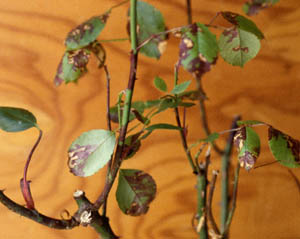Rose Downy Mildew Suspects | |
|---|---|
| April 25, 2007 | |
|
This is the season to watch for rose downy mildew, especially if you have a production facility, holding zone under plastic, or overhead irrigation for your roses. Because the disease can become systemic and be carried in cuttings taken from infected stock, it is imperative that the disease is controlled in production areas. Downy mildew is caused by the fungus Peronospora sparsa, which grows best in cool conditions (60? to 70?F) where the humidity is above 85%, like conditions in many greenhouses and polyhouses in the spring. Downy mildew symptoms on rose include lesions on the leaves, stems, and flowers. The leaf lesions appear purplish to brown, blocky, and are often accompanied by yellowing of surrounding tissues as seen in the attached image.  Calls of concern at this time of year involve another alarming symptom—severe defoliation. Calls of concern at this time of year involve another alarming symptom—severe defoliation. We can confirm the disease in the lab fairly quickly. The downy mildew fungus forms a downy mass of spores on the underside of leaf lesions. This downy growth is difficult to see without a hand lens or microscope but is visible on the underside of each lesion. In the lab, we place leaves in humidity chambers over night for easy viewing of spores the next day. An image of diagnostic conidiophores and spores viewed with a compound microscope follows.  The fungus affects newest growth first and is easily spread by wind-blown spores. It may then become systemic in a plant. There are chemicals available to control the fungus. There are many options listed in the 2007 Commercial Landscape and Turfgrass Pest Management Handbook, as well as in the Home, Yard, and Garden Pest Guide. These products are listed as preventives and work best before the disease is established. Look at the table at the end of the chapter to see a listing of fungicides, active ingredients, mobility, and company selling the product. Be sure to get thorough coverage of the foliage, especially the underside of leaves. Because the fungus survives on infected plant parts, remove infected tissue from the site. Place tissue directly into a plastic bag and seal it before moving through the garden. For more information about rose fungicide ratings, consult HYG Pest news 2005, no. 10. Products suggested for downy mildew use are also listed on the Oregon State fact sheet at http://plant-disease.ippc.orst.edu/disease.cfm?RecordID=985. |